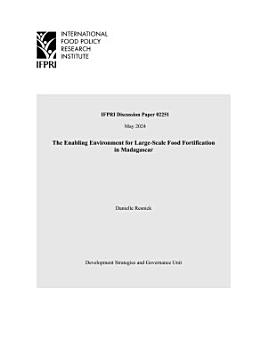The enabling environment for large-scale food fortification in Madagascar
About this ebook
Drawing on semi-structured interviews with 31 knowledgeable stakeholders in Madagascar in the areas of mandatory fortification of salt, voluntary targeted fortification of infant flour, and fortification of foods for humanitarian assistance, the framework reveals several key priorities. First, weak governance overall affects several dimensions of nutrition and fortification policy, including policy momentum, commitment, and communication. Nutrition interventions therefore need to be calibrated to the country’s broader political risks, incentive structures, and capacities of relevant civil servants. To this end, fortification advocates should go beyond drawing on the expertise of nutrition professionals alone and also engage public sector governance experts as partners in fortification efforts. Second, major priorities for investment include a large-scale micronutrient and consumption survey to update information on micronutrient deficiencies and identify viable food vehicles for mass fortification. Third, an accredited laboratory to test micronutrients is sorely needed in the country to help reduce costs faced by companies who currently send their products overseas for testing and who face competition from counterfeit products. Fourth, financial and technical partners must pursue a multi-pronged lobby approach to overcome high government taxes on imported premix. Fifth, the National Food Fortification Alliance, which serves as a multi-stakeholder platform, requires a sustainable financing model to attract committed leadership and ensure consistent coordination activities. These and other lessons hold policy relevance for other low-income and fragile settings where LSFF is being considered as an option to address micronutrient deficiencies.










